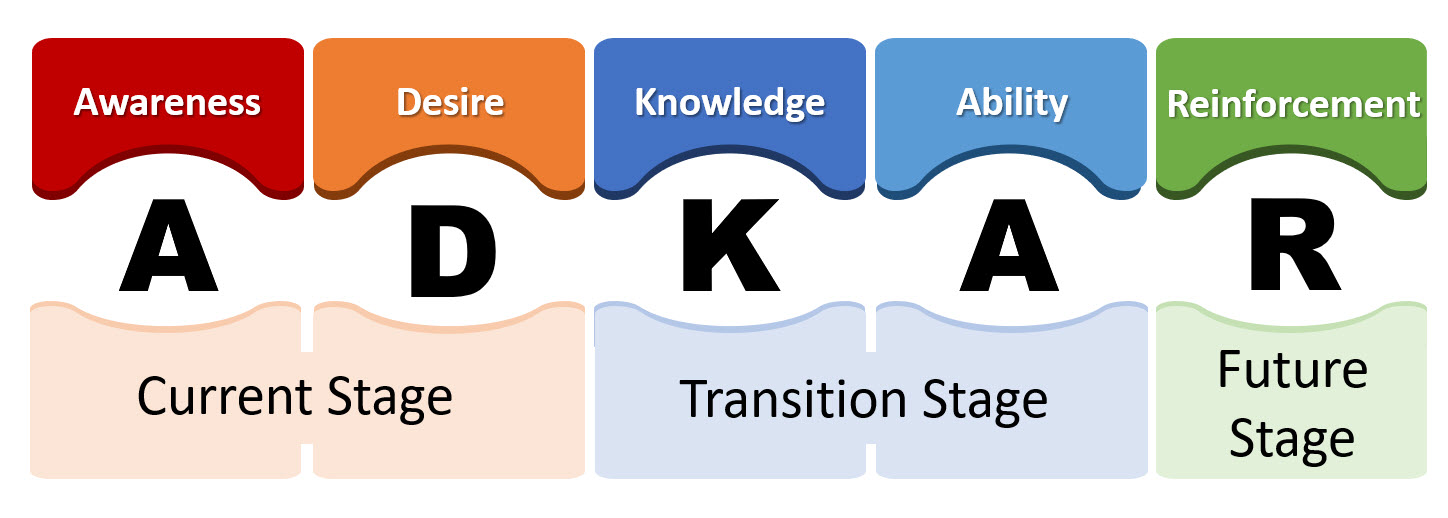What is Prosci ADKAR® Model?
The Prosci ADKAR® Model is a goal-oriented change management tool. The model was founded by Jeff Hiatt in 2003 and was introduced and registered as a practical tool by Prosci.
The acronym ADKAR stands for the five tangible and concrete outcomes that people and organisations need to achieve the required change. The ADKAR acronym stands for Awareness, Desire, Knowledge, Ability and Reinforcement.
Why ADKAR Model?
The ADKAR model is an effective and widely used tool for planning change management activities, facilitate change for leaders, help and assist the employees throughout the change process within the organisation. As well, the ADKAR model focuses on the people element of change to achieve organisational success. ADKAR model is designed in a way to ensure each individual is experiencing the change move through the five phases of the model.
The model is developed based on practical research and study of more than 900 organisations across 59 countries throughout 20 years.
Appling the ADKAR model to the change initiatives allows:
- Employees to understand the benefits of adopting new technologies and tools.
- Prepare successful employees for the new environment.
- Equipping leaders with the tools to manage the change and resistance effectively.
- Change to occur as a process rather than as an event.
ADKAR model breaks down the three stages of change (Arnold Van Gennep - 1909, Kurt Lewin – 1948, William Bridges – 1980) into distinct phases of change:
Current stage: Awareness & Desire
Transition stage: Knowledge & Ability
Future stage: Reinforcement

The ADKAR Model
Hiatt refers to each of five sequential actions as building blocks for successful individual change, and therefore successful organisational change. Being sequential means each step must be fully completed before moving into the next step.
Let’s take a look at each of the five acronyms of the ADKAR model:
Awareness
During the awareness step, leadership must make their employees aware of the reason and the necessity for the change that is about to occur, and ensure their employees of “What changes are going to occur”.
Keeping people unaware can lead to employee’s loss of direction and motivation. Leaders have a crucial role in ensuring the employees are fully aware of every activity and element of the change process. Hence, applying a planned open approach in communication is essential. This can be done through the following mean:
- Utilising internal corporate communication tools such as emails and media platforms.
- Facilitated face to face team meetings or corporate event.
- One to one meeting if needed and deemed necessary for some levels.
Desire
In this step, the employees need to willingly reach the point of making personal decision to support and participate in the change process and its activities. Building the desire is partly achieved by addressing individual incentives and creating an inner desire to be a part of that change.
Knowledge
The change will bring change to employee’s skills and knowledge. Employees should be fully supported in their development and acquisition of these skills and knowledge. This can be achieved through providing standard training, while other learning interventions would be beneficial, such as; coaching, on the job training, and job shadowing.
Ability
In this model, the ability is defined and understood as the difference between theory and practice. Once the knowledge and skills acquired, building the necessary abilities is a must to reach the desired performance levels. Individuals need to be supported, this can be achieved through practice, providing continuous feedback and coaching interventions.
Reinforcement
Reinforcement is a necessary step to resist the employee’s temptation to slipping back into the old habits. It is important to reinforce by providing positive feedback, an effective reward system and continuous recognition of performance need to be in place.
Tips: the following link could be with great adding value to change management: “Kotter’s 8 Step Approach” and “Gaplin, Change Resistance Pyramid”.

Comments
No Comments added, be the first...